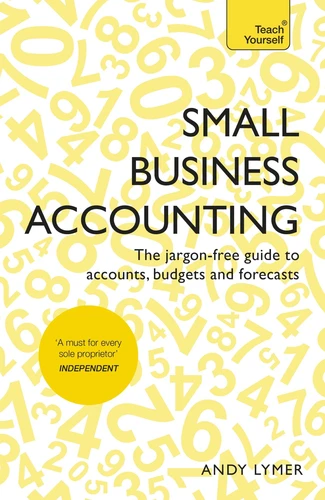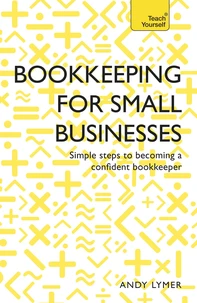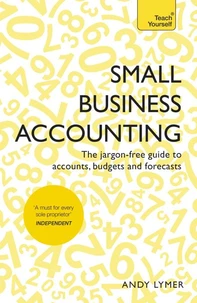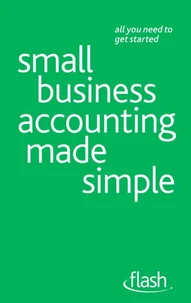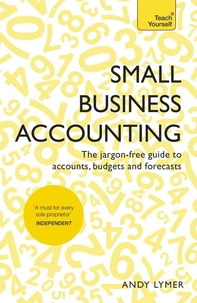Small Business Accounting. The jargon-free guide to accounts, budgets and forecasts
Par :Formats :
Disponible dans votre compte client Decitre ou Furet du Nord dès validation de votre commande. Le format ePub protégé est :
- Compatible avec une lecture sur My Vivlio (smartphone, tablette, ordinateur)
- Compatible avec une lecture sur liseuses Vivlio
- Pour les liseuses autres que Vivlio, vous devez utiliser le logiciel Adobe Digital Edition. Non compatible avec la lecture sur les liseuses Kindle, Remarkable et Sony
- Non compatible avec un achat hors France métropolitaine
 , qui est-ce ?
, qui est-ce ?Notre partenaire de plateforme de lecture numérique où vous retrouverez l'ensemble de vos ebooks gratuitement
Pour en savoir plus sur nos ebooks, consultez notre aide en ligne ici
- Nombre de pages352
- FormatePub
- ISBN978-1-4736-2362-0
- EAN9781473623620
- Date de parution26/08/2015
- Protection num.Adobe DRM
- Infos supplémentairesepub
- ÉditeurTeach Yourself
Résumé
Is this the right book for me? A jargon-free guide for the small business owner or manager Small Business Accounting is a jargon-free joy for the small business owner or manager, providing practical examples of real businesses to show the reader, step by step, how to record each transaction. This book does not assume that you know anything at all about business records and accounts and gives a system for real businesses to be operated by real business people who want a simple, easy and, above all, quick system of book keeping.
Forget about debits and credits, journal entries, ledgers and day books. If you can read a bank statement this book will teach you how to prepare accounts, make cashflow forecasts and prepare a budget. And when you do need to use an accountant, it tells you how best to find a reliable one. Small Business Accounting includes: Chapter 1: Introduction Chapter 2: Your bank account Chapter 3: A simple cashbook Chapter 4: Analysis columns Chapter 5: Payments - filing Chapter 6: Payments - cheque-book Chapter 7: Payments - cashbook Chapter 8: Non-allowable expenses Chapter 9: Purchase of equipment Chapter 10: Credit cards Chapter 11: Petty cash Chapter 12: Receipts - filing Chapter 13: Receipts - paying-in book Chapter 14: Receipts - cashbook Chapter 15: Capital introduced Chapter 16: End of month procedures Chapter 17: VAT Chapter 18: Wages Chapter 19: End of year totals Chapter 20: Adjustments for payments Chapter 21: Adjustments to receipts Chapter 22: Transfer to tax return Chapter 23: Trial balance Chapter 24: Final accounts Chapter 25: Budgeting and cash-flow forecasting Chapter 26: Costing and pricing Chapter 27: Computerization
Forget about debits and credits, journal entries, ledgers and day books. If you can read a bank statement this book will teach you how to prepare accounts, make cashflow forecasts and prepare a budget. And when you do need to use an accountant, it tells you how best to find a reliable one. Small Business Accounting includes: Chapter 1: Introduction Chapter 2: Your bank account Chapter 3: A simple cashbook Chapter 4: Analysis columns Chapter 5: Payments - filing Chapter 6: Payments - cheque-book Chapter 7: Payments - cashbook Chapter 8: Non-allowable expenses Chapter 9: Purchase of equipment Chapter 10: Credit cards Chapter 11: Petty cash Chapter 12: Receipts - filing Chapter 13: Receipts - paying-in book Chapter 14: Receipts - cashbook Chapter 15: Capital introduced Chapter 16: End of month procedures Chapter 17: VAT Chapter 18: Wages Chapter 19: End of year totals Chapter 20: Adjustments for payments Chapter 21: Adjustments to receipts Chapter 22: Transfer to tax return Chapter 23: Trial balance Chapter 24: Final accounts Chapter 25: Budgeting and cash-flow forecasting Chapter 26: Costing and pricing Chapter 27: Computerization
Is this the right book for me? A jargon-free guide for the small business owner or manager Small Business Accounting is a jargon-free joy for the small business owner or manager, providing practical examples of real businesses to show the reader, step by step, how to record each transaction. This book does not assume that you know anything at all about business records and accounts and gives a system for real businesses to be operated by real business people who want a simple, easy and, above all, quick system of book keeping.
Forget about debits and credits, journal entries, ledgers and day books. If you can read a bank statement this book will teach you how to prepare accounts, make cashflow forecasts and prepare a budget. And when you do need to use an accountant, it tells you how best to find a reliable one. Small Business Accounting includes: Chapter 1: Introduction Chapter 2: Your bank account Chapter 3: A simple cashbook Chapter 4: Analysis columns Chapter 5: Payments - filing Chapter 6: Payments - cheque-book Chapter 7: Payments - cashbook Chapter 8: Non-allowable expenses Chapter 9: Purchase of equipment Chapter 10: Credit cards Chapter 11: Petty cash Chapter 12: Receipts - filing Chapter 13: Receipts - paying-in book Chapter 14: Receipts - cashbook Chapter 15: Capital introduced Chapter 16: End of month procedures Chapter 17: VAT Chapter 18: Wages Chapter 19: End of year totals Chapter 20: Adjustments for payments Chapter 21: Adjustments to receipts Chapter 22: Transfer to tax return Chapter 23: Trial balance Chapter 24: Final accounts Chapter 25: Budgeting and cash-flow forecasting Chapter 26: Costing and pricing Chapter 27: Computerization
Forget about debits and credits, journal entries, ledgers and day books. If you can read a bank statement this book will teach you how to prepare accounts, make cashflow forecasts and prepare a budget. And when you do need to use an accountant, it tells you how best to find a reliable one. Small Business Accounting includes: Chapter 1: Introduction Chapter 2: Your bank account Chapter 3: A simple cashbook Chapter 4: Analysis columns Chapter 5: Payments - filing Chapter 6: Payments - cheque-book Chapter 7: Payments - cashbook Chapter 8: Non-allowable expenses Chapter 9: Purchase of equipment Chapter 10: Credit cards Chapter 11: Petty cash Chapter 12: Receipts - filing Chapter 13: Receipts - paying-in book Chapter 14: Receipts - cashbook Chapter 15: Capital introduced Chapter 16: End of month procedures Chapter 17: VAT Chapter 18: Wages Chapter 19: End of year totals Chapter 20: Adjustments for payments Chapter 21: Adjustments to receipts Chapter 22: Transfer to tax return Chapter 23: Trial balance Chapter 24: Final accounts Chapter 25: Budgeting and cash-flow forecasting Chapter 26: Costing and pricing Chapter 27: Computerization

